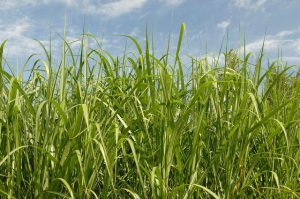A major challenge of using biomass for bioenergy is the breaking down of biomass into cellulose that can be used as the basis for biomaterials. One researcher is trying to overcome this barrier when using perennial plants for renewable energy. Feng Wang, associate professor of physical chemistry at University of Arkansas, has been awarded $400,000 from the National Science Foundation to study this challenge.

A University of Arkansas researcher is investigating a critical roadblock to harvesting biomass from perennial plants, such as grass, for the purpose of creating renewable energy. Photo Credit USDA.
“Biofuel derived from perennial plants, such as grass and common weeds, is most desirable because these plants grow on marginal land and can be harvested repeatedly,” said Wang, who works in the J. William Fulbright College of Arts and Sciences. “But first we have to solve the problem of breaking down cellulose fibrils before biomass can be considered an economically viable source of renewable energy.”
Wang explains that cellulose fibrils are microfibers of inert carbohydrates within plants and give wood, for example, its durability. Through pretreatment chemists separate these fibrils into individual carbohydrate chains that can be digested by enzymes but this process takes a long time. However, Wang and other chemists are studying ways to speed it up.
According to Wang, computational modeling is an important route toward understanding this process. He and his team is developing computer models of cellulose fibrils to help scientists understand how they interact with water, alternative solvents and enzymes. His and other models will also lead to the design of catalysts for the pretreatment and hydrolysis of biomass. Wang will use a method called adaptive force matching, which relies on a process using repeated iterations for developing simple but highly efficient and accurate force fields.
“The beauty of this method is that it allows us to develop accurate force fields without using complex energy expressions,” said Wang. “And maximizing its simplicity will enable larger structures to be modeled efficiently.”
Using the adaptive-force-matching method as a reliable protocol for mapping the molecular energy landscape of cellulose fibrils will have broad impact for computational chemistry and material research in general, Wang said. The ultimate goal is to understand the mechanisms that prevent scientists from making clean and renewable fuel from biomass, which would decrease reliance on fossil fuels and reduce carbon emissions.

